The first thing I noticed about Poros wasn’t the view of Galeta across the 200-metre-wide channel that separates the island from the mainland. It wasn’t the scenic sail across the Saronic Gulf on our approach to the port. It wasn’t even the class of boat moored in the harbour. It was the people. And more specifically, their age. Not quite God’s waiting room but perhaps the room next door. Of all the places we’ve visited, Poros is one I’d come back to and stay awhile. It has that winning combination of being both an island and within a water taxi of the mainland. It’s more settled in itself, more mature, more boaty.
I’d gotten used to the sight of white cubed houses perched on the side of a hill. I’d stopped commenting on the dome-shaped churches. I was still marvelling at the neo-classical mansions though.


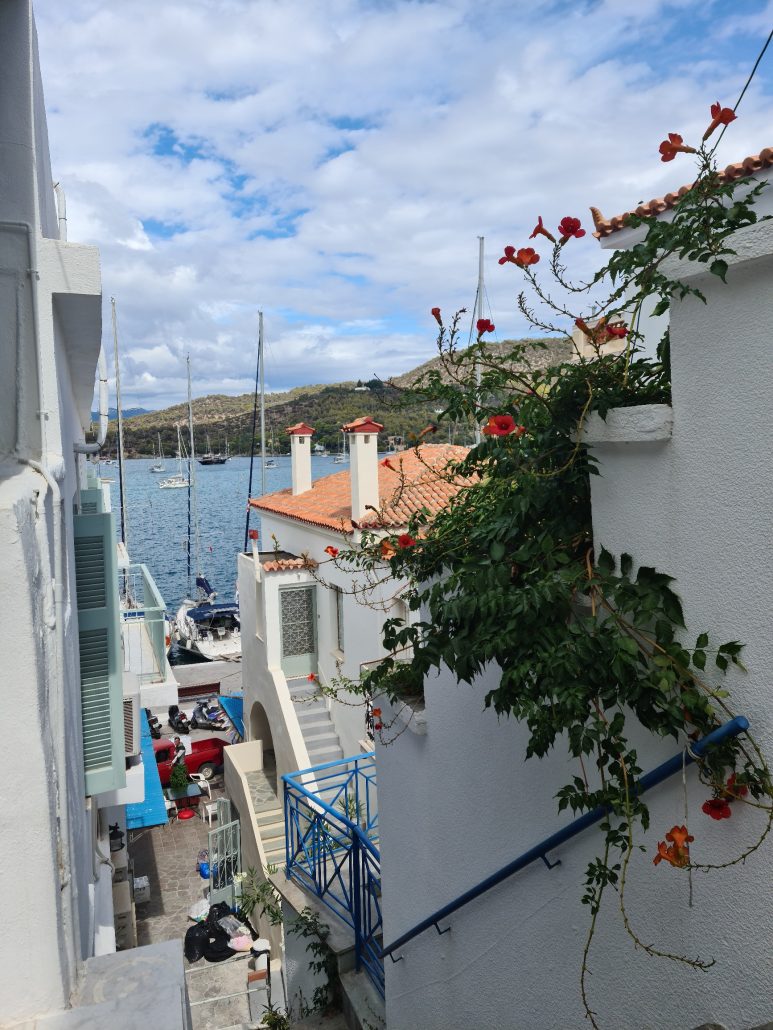
Having coffee one evening, I heard an Irish accent and introduced myself. Its owner had sailed here from Ireland and was hanging around for the winter. Retired from the construction business and with a pub or two to his name in the old sod, he was well set up. His boat was the same size as ours but his had him, his wife, and their dog. Such space!
In a small local bar on a square outside the chandlers, he regaled us with stories of retirement on the high seas. He was in good company. All around us, middle-aged (using the new, more generous, UN age bracket) couples were sipping their aperitifs, getting ready to dine onboard or head out for dinner to one of the many restaurants lining the shore. For the first time, there were more locals than tourists, which added to the authenticity of the place. It actually felt Greek even though it was obviously an international port of call for many.
The bakeries, the laundries, the craft shops, the bookstalls, it all had a lived-in feel to it as if it wasn’t there just to serve the tourists. Skippers of all nationalities guided their flotillas ashore. Crews wearing their emblemed polo shirts with their ship’s colours set their high tables with silverware and crystal glasses. Sailors enjoyed cold beers on board and ashore, introducing themselves as a matter of course. Poros is a serious sailing town – no one is playing around here.

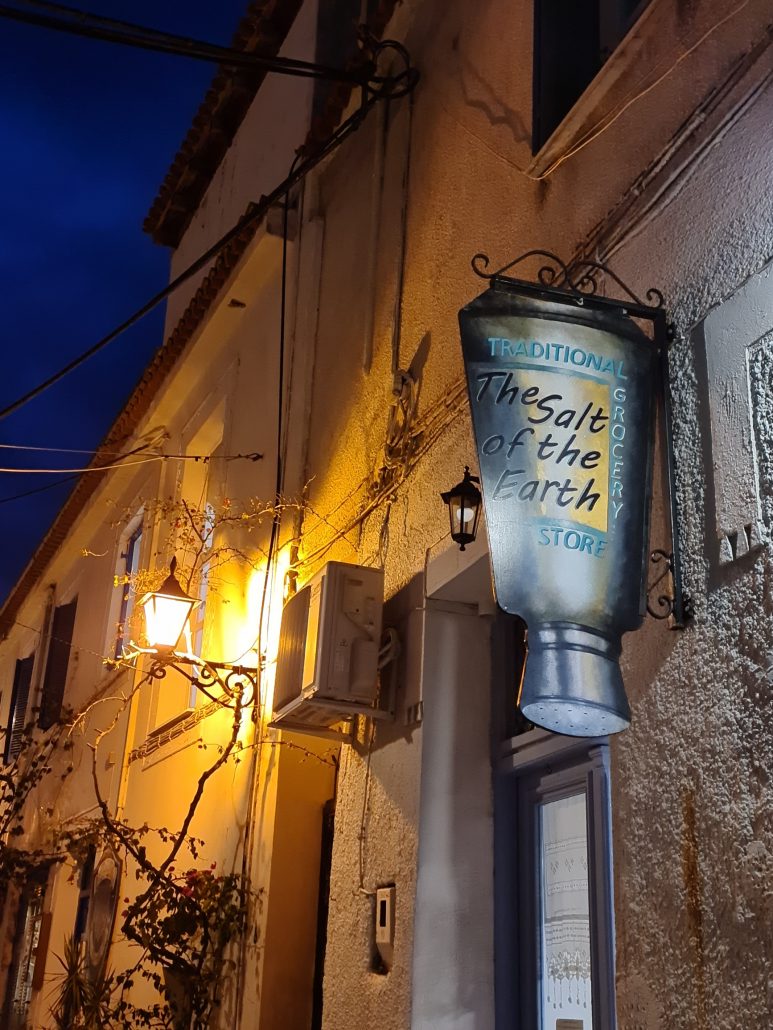

Poros is actually two islands, Spheria and Kalavria, joined together by a spit. The ruins of the old Russian Dockyard are on Kalavria. The Greeks and Russians were quite tight in the eighteenth and nineteenth centuries with the Russians dropping by to give Greece a dig out in its war against Turkey back in the 1820s.
Today, Poros is home to the Hellenic Naval Academy, which has signs posted in multiple languages telling anyone who cares that photos are forbidden.
The origin of the Modern Greek navy is attributed to the private merchant ships, which fought in the Greek war of independence against the Ottoman Empire, in 1827. The merchant fleet from the islands of Hydra, Spetses, Psara, and Poros participated in the war. Those who led these fleets were Constantine Kanaris of Psara, Andreas Miaoulis of Hydra and the efficient woman captain, Laskarina Bouboulina.
I’d bumped into Miaoulis in Hydra, hadn’t so far heard of Kanaris, but was intrigued by Bouboulina. She was born in 1771 in a prison in Constantinople where her father was serving time (I’m not quite sure what her mum was doing in the prison though), married twice, and lost both sea-captain husbands named Dimitris to pirates. While raising seven kids, she built three ships of her own, including the largest Greek ship used in the War of Independence. She was some woman.
Her’s was a tragic end.
In 1825, Laskarina Bouboulina was killed in a very unfair and unexpected manner, when a member of Koutsis family shot at her. They had come to question her about her son, Georgios Yiannouzas, who had eloped with their daughter. After her death, Bouboulina was the first woman to be awarded the rank of Admiral by the Russian Navy.
There’s a lovely mermaid statue by sculptor Giorgos Xenoulis, who is also noted for the Boy and the Dolphin statue in Hydra (how did I miss that?). Xenoulis spent years in Central and South Africa and only returned to Athens in the 1990s. In Greek mythology, the Nereids (mermaids) were ‘daughters of Nereus, oldest son of Pontus (The Sea) and Gaia (The Earth), and grandfather of the hero Achilles’.
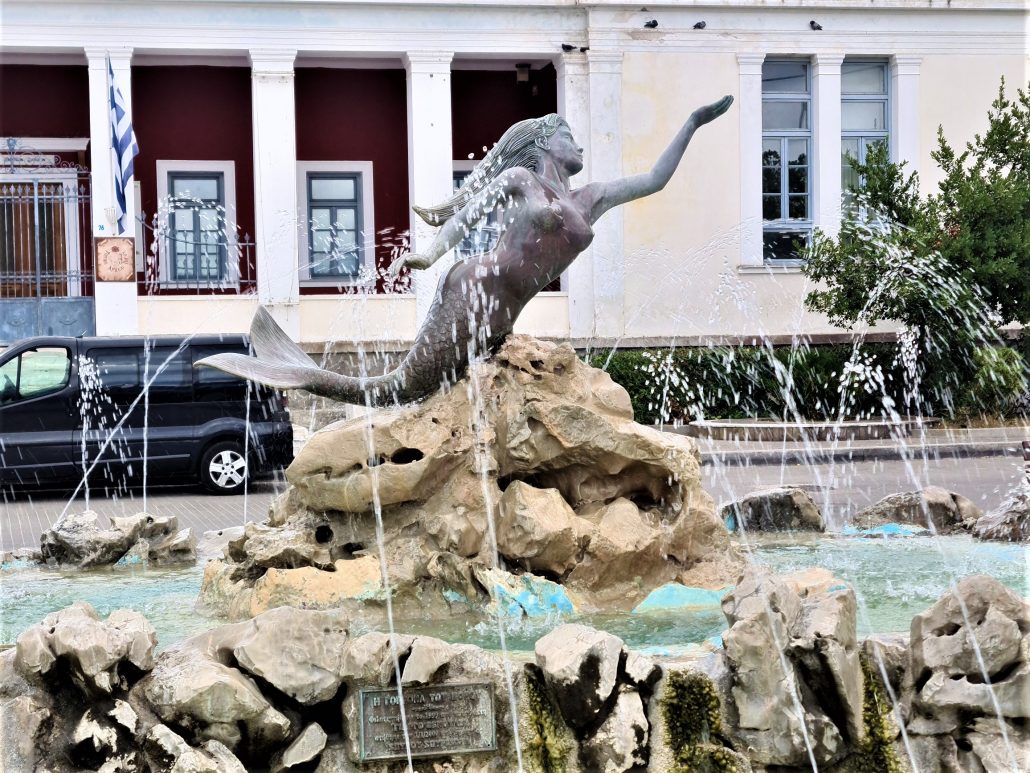
Given that I’ve been surrounded by mythology for the last couple of weeks, I so wanted to imbue these footprints with a story but I was more concerned with trying to fathom how people bring their groceries home.

Since its first tick in 1927, the clock tower has been marking time in Poros. There’s a climb up to it, through narrow, winding streets, populated with tiny shops and bearing names like Greta Garbo and Henry Miller, that read like an autograph book of famous people who’ve spent time in the town.


Today, many people, famous in their own worlds of wealth and extravagance dock for a night or two in boats that comfortably sleep 12 and more and cost upwards of €300k a week to rent. There’s plenty of money on show.
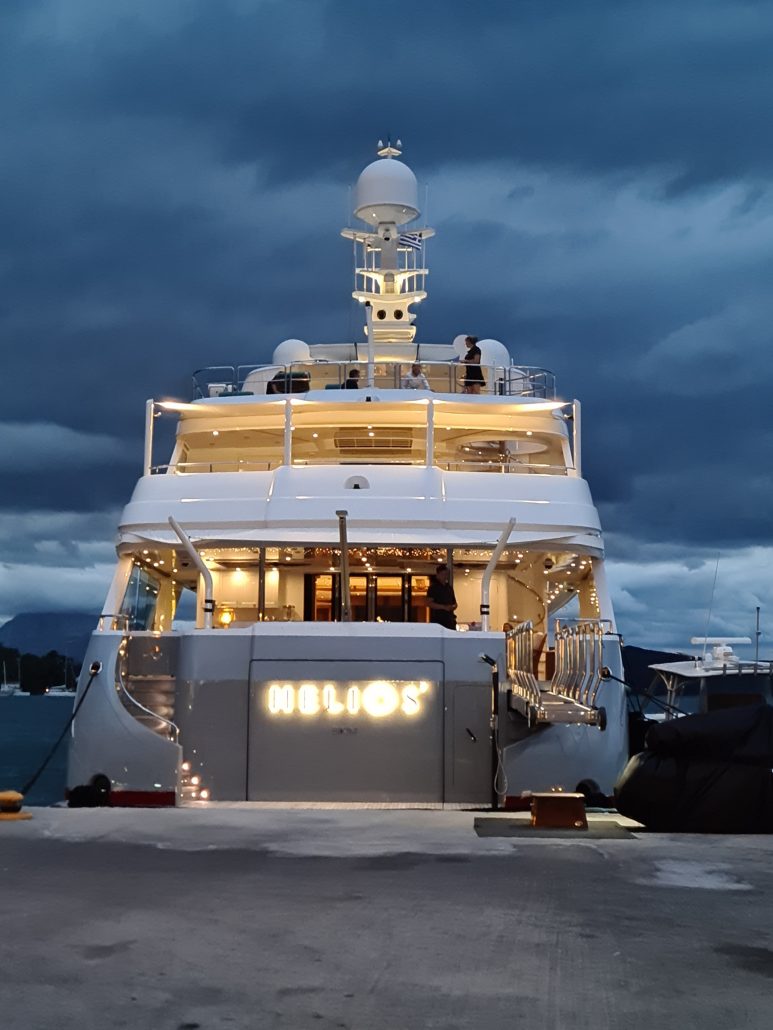

I was curious about flag etiquette – and there is such a thing. Marla flew a house flag from Howth Yacht Club in Dublin as a nod to our skipper. House flags follow the sailor, not the boat. We didn’t have a courtesy flag as we were on a Greek boat but if we’d taken that boat to, say, Malta, we’d have flown the Maltese flag as a courtesy.

A lot of the bigger boats we saw were flying Maltese flags. It’s fourth on the list of best places to register your yacht for tax reasons, following Liberia, the Marshall Islands, and the Caymans.
The chosen port of registry will determine the nationality of the vessel and the laws and regulations that will apply to its operation. The flag flown and the port of registry inscribed on the stern of the vessel provides the vessel with an identity – a strong well-founded flag will suggest a lot about the owner and the standards to which the vessel is operated.
Poland is currently offering a life-long registration for €600. If you’re interested.

Miller and Garbo alongside Marc Chagal and James Merrill were frequent guests of the Villa Galini, one of the few other-coloured houses in the town. It’s a private house now and not open to visitors. Nobel laureate George Seferis was also a regular there. His was a fascinating life.
I read something he wrote about Poros on the back of a menu:
Perhaps it’s the island…
Time seems to freeze here…
It’s the island of Calypso…
One has to make the decision
to leave Poros for Ithaca at some point
The “concrete” Itacha.
The sea smoothly moves
like silk in grey,
blue, purple and pink colours…
I’m leaving Poros…
Without knowing if I will ever find
the great serenity I felt in the
mornings here lately…
I get that. Completely. Time really does seem to freeze here.
We were a day ahead of our boat, having gotten weathered in, in Hydra. We stayed in the fabulous Manessi City Boutique Hotel, a family-run hotel in an old neo-classical mansion – €45 a night with bathrobes 🙂 And enjoyed a real bed for the second night on the trot.
Had we had more time still, I’d have gone to see Lemonodassos, the Lemon Tree forest with its tens of thousands of lemon trees but I’ve made a note to come back when they’re in bloom in May. I’d also have made the time to go see the 1720’s Holy Monastery of Zoodochos Pigi and have a sup of its healing waters said to have cured the Archbishop of Athens of his lithiasis (stones). And had the weather been cooperative, I’d happily have spent a day on the beach at Russian Bay or Askeli. It’s definitely on my list of places to go back to. Close to Athens with frequent ferries to other islands and water taxis to the mainland… I could think of worse places to winter.

Share this:
- Click to share on Twitter (Opens in new window)
- Click to share on Facebook (Opens in new window)
- Click to share on Pinterest (Opens in new window)
- Click to share on LinkedIn (Opens in new window)
- Click to share on Reddit (Opens in new window)
- Click to share on WhatsApp (Opens in new window)
- Click to share on Pocket (Opens in new window)
- Click to share on Telegram (Opens in new window)
- Click to email a link to a friend (Opens in new window)



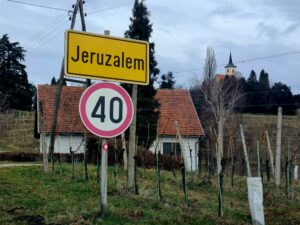



2 Responses
It all sounds sooo perfect, and it seems like you have your sea legs now too – congrats. I’m hoping you’ve been reading Homer…